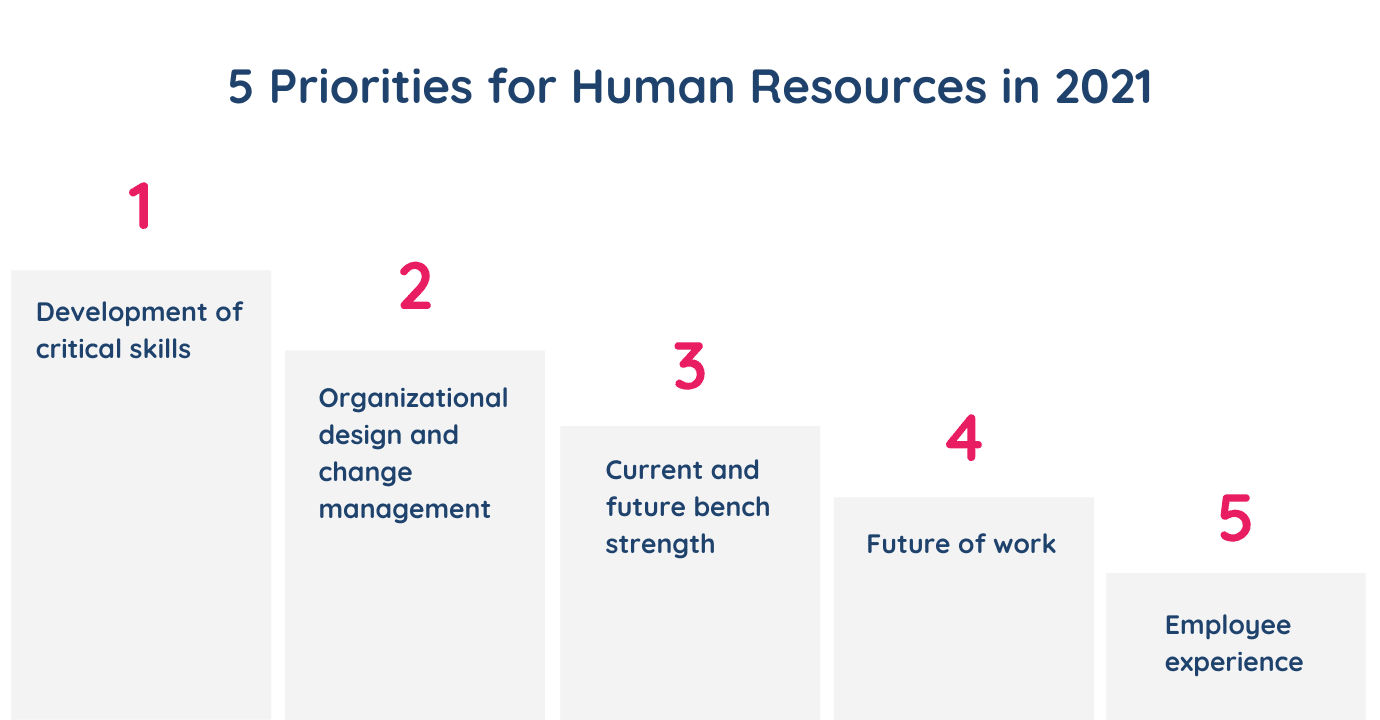With the COVID-19 outbreak, priorities for human resources have changed dramatically. In addition to recruiting and retaining talent, HR managers must now support the implementation of new ways of working, while ensuring compliance with drastic health measures.
In order to better understand HR trends in the COVID era, we analyzed a Gartner Institute global study conducted between June and August 2020, which surveyed more than 800 HR managers from all sectors.
This study identified five human resources priorities for 2021:
- Development of critical skills
- Organizational design and change management
- Current and future bench strength
- Future of work
- Employee experience

1) Building critical skills
68% of human resources managers believe that the number one priority for 2021 is to develop employees’ critical skills. Indeed, the COVID-19 crisis has significantly increased the need for training: the HR managers Gartner surveyed estimate that more than 40% of workers must now call upon new skills (linked in particular to the emergence of hybrid work).
Also read: [Expert Voice] Sandrina Correia (HR Director at EVA Group): How Has HR Adapted to the Lockdown?
In order to identify and develop these new skills quickly, companies need to boost their training policy. A new approach that can be achieved through several initiatives:
- Developing a network of internal stakeholders (other than human resources) responsible for identifying skills needs.
- Implementing accelerated training programs.
- Empowering employees by providing them with relevant information through thematic groups, which will enable them to make better decisions.
By adopting a proactive training approach, Gartner estimates that by 2021, companies will be able to integrate 75% of the skills now required into their employees’ jobs (far more than with traditional training approaches).
Also read: Vincent Montet, EFAP: “ Training is one of the answers to Digital Darwinism”
2) Organizational design and change management
For several years, many companies have been creating workflows to boost work efficiency. However, this type of organizational structure creates friction within teams and no longer suits current market needs. Because of these rigid processes, employees are not very responsive and have difficulty adapting quickly to change.
Just 19% of human resources managers surveyed report that their company’s employees are able to change direction when needs or priorities change. So much so that, according to an October 2020 Gartner study, employees’ ability to assimilate change in 2020 was halved compared to the previous year.
To improve this responsiveness, it’s necessary to rethink the organizational structure to make it more flexible. By 2021, 46% of HR managers want to make this a priority. Several solutions can be put in place to facilitate change management:
- Realign the organizational structure with current practices by making ongoing adjustments.
- Clarify organizational rules to better prioritize tasks.
- Make decisions as close as possible to the end users to improve resource mobility.
- Formalize process change approaches to accelerate decision making.
3) Current and future bench strength
Nearly half of human resources managers say that the processes in place within their company don’t allow the right leaders to emerge at the right time. For example, only 44% of employees have confidence in the ability of senior management and managers to effectively manage a crisis.
This problem of trust is partly due to the lack of management diversity, identified by 50% of the HR managers surveyed. Indeed, in American companies, only 10% of senior positions in companies are held by a woman belonging to a racial or ethnic minority.
To address this issue, Gartner suggests that organizations implement a networking program, which will help create more diversity within the network. According to Gartner, companies using this type of program are 3.4 times more likely to improve talent mobility.
4) Future of work
More than a third of HR managers want to make the future of work a priority. However, 62% admit that their company does not have a specific strategy to deal with this new trend.
The health crisis has had a very visible impact on the way we work. According to Gartner, several trends have accelerated this year, such as teleworking, part-time work, but also the collection of employee data. In addition, it appears that the company tends to be more and more involved in the well-being of its employees.
Also read: Deloitte Predicts 5 Key HR Trends for 2021
On the human resources side, the new imperative is now to identify, among the major trends, those that are most relevant to their company’s activity, and to test several scenarios to create spheres of innovation.
5) Employee experience
Employee experience is a major priority for 28% of human resources managers, 31% of HR managers and 48% of diversity and inclusion managers. However, the rise of the hybrid work model, which is expected to affect almost 50% of employees in 2021, complicates the task for human resources.
To reduce the impact of telecommuting, organizations need to adapt the employee experience. Here are several good practices to follow:
- Change your recruitment and talent attraction strategy and adjust your employer value proposition.
- Digitize your onboarding process to reduce costs and further personalize the collaborative experience.
- Analyze your workplace wellness strategy and identify areas for improvement.
- Explain to managers how to redefine employee objectives and how to manage based on results.
- Adjust your rewards and recognition strategies to accommodate your new hybrid workers.
- Set up communication and collaboration solutions to connect your employees.
- Use e-learning solutions and update your talent management practices to fit a hybrid environment.
Also read: [Expert Voice] Bertrand Duperrin: Towards a Hybrid Work Model
*
* *
The year 2021 is an opportunity for human resources to develop the skills of its employees, change the roles and responsibilities of managers, and implement digital HR strategies. In this era of hybrid work, human resources managers must above all prioritize flexibility—a key skill for navigating in an uncertain environment.
Want to find out more about hybrid work and the role of the HR function in this new situation? Read our white paper: “The Future of Work: Make Way for Hybrid!”
Access White Paper
In our white paper “Future of Work: Time for Hybrid Work! “you will discover the eight main challenges of hybrid work; best practices managers should adopt, HR, internal communication, IT and employees; and the tools to be implemented to facilitate hybrid work.
_
Author: Emmanuelle Abensur



